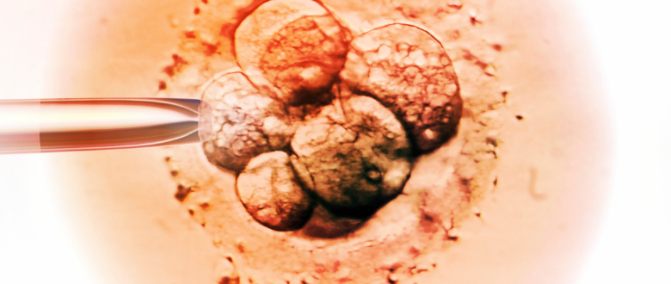Frozen embryo transfer (FET) is a boon for couples who either cannot proceed with a fresh embryo transfer for medical reasons or want to have future attempts.
Research shows that frozen embryo transfers make up about 50% of the embryo transfers done in assisted reproductive centers.
What is Frozen Embryo Transfer?
Frozen embryos are embryos that were formed in previous IVF cycles and were frozen for later use.
How are embryos frozen?
After the egg and sperm are fertilized in the laboratory, the resulting embryo is allowed to develop for a few days.
“An embryologist selects the embryos appropriate for freezing because not every embryo can withstand the process,” explains Dr. Priti Arora Dhamija, Fertility expert and Consultant Obstetrician-Gynecologist at Sitaram Bhartia Hospital in South Delhi.
The embryo is then placed in a solution that prevents it from getting damaged due to freezing. The embryo is frozen using an advanced technique through which it is quickly brought to sub-zero temperatures.
The embryo is stored in liquid nitrogen until the couple decides to use it.
In what situations is frozen embryo transfer recommended?
Your doctor may suggest freezing embryos for later use if you
- are unwell at the time of the egg retrieval process
- have a fibroid or polyp in the uterine cavity that may interfere with implantation
- have not yet developed a good uterine lining for fresh transfer
- are at risk of developing ovarian hyperstimulation syndrome (OHSS)
- have experienced failed cycles from fresh transfers
- are using donor embryos or surrogates
- or have extra good quality embryos that can be used in future attempts
Diya Thomas, 32, was diagnosed with mild to moderate endometriosis a year ago. When she could not conceive naturally, she was suggested Intrauterine Insemination (IUI). After two failed IUI cycles, she was devastated. She was about to give up hope completely when her fertility specialist advised IVF.
Reluctantly, she agreed.
Shortly after her eggs were retrieved and the semen from her husband was collected, she developed fever.
Upon consulting Dr. Priti through telemedicine, the couple began considering freezing their embryo.
After how long can you have a frozen embryo transfer?
Studies show that a frozen embryo transfer can be deferred for 10 years or more. In one case in the U.S., a couple successfully gave birth by using an embryo that had been frozen for 25 years.
Diya and her husband Nikhil understandably had many questions about the frozen embryo transfer timeline, procedure, success rates and possible risks.
What is the process for frozen embryo transfer?
After your eggs have been retrieved and semen has been collected, the best quality sperm will be selected and fertilized with the egg under controlled conditions in an IVF laboratory.
“The resulting embryos are allowed to grow for 3-5 days,”says Dr. Priti as she describes the frozen embryo transfer step by step.
After this, the embryo will be frozen until you decide to use it.
The process of deferring the transfer allows the woman’s body to recover from the medications or injections given during IVF. This helps create an environment devoid of stress and more conducive to implantation.
What cycle day is frozen embryo transfer?
“We will wait about a fortnight after the eggs are retrieved. By this time, you will begin your menstrual cycle. “
“We will assess the endometrium lining through an ultrasound and then give medication to build the uterine lining and make it receptive.”
“The lining will be examined again after one week through an ultrasound. About 5 days after this, once the lining is sufficiently thick, you will be given hormonal injections and the frozen embryo transfer will be done after 4-6 days.”
“On a predetermined date and time, the embryo will be thawed and then inserted into the uterus using a catheter. You will not require anesthesia for the process. After it is performed you can go back home the same day.”
Is frozen embryo transfer better than fresh?
Some studies suggest that pregnancy rates with frozen embryo transfers may be better than fresh embryo transfers. The subjects in the studies, however, were women younger than 35 years. Differences have been observed in older women.
According to another study on women (426 fresh ET and 588 FET) undergoing ICSI treatment “there was no significant difference in fertility success rates between the fresh and the frozen embryo transfer groups.”
“It is difficult to say which method is the best. It really depends on your situation, age and medical history,” says Dr. Priti.
How successful is frozen embryo transfer?
Deferred embryo transfer has been seen to have pregnancy success rates similar to those for natural conception.
“However, this may not apply to every couple,” informs the doctor.
Nikhil wanted to know if there were any potential risks in the procedure.
Are there any risks with FET?
FET like a fresh embryo transfer may increase the risk of ectopic pregnancy or multiple pregnancies.
How much does a frozen embryo transfer cost?
If you have previously undergone a fresh embryo transfer that was not successful, you can opt for a frozen embryo transfer at a lower cost (than having to go through the entire IVF cycle again).
“We advise couples to talk to their fertility specialist about freezing their embryos at the time of the first IVF cycle itself. Freezing suitable embryos at this stage can help with attempts in the future.”
Having learned all the facts Diya and Nikhil understood that given their situation, frozen embryo transfer was the better option.
A month later, they came in for the frozen embryo transfer. The couple wanted to learn about implantation after frozen embryo transfer and any tips to keep in mind.
They asked the doctor what to do after embryo transfer.
Precautions after Frozen Embryo Transfer
There are no definite precautions to take after frozen embryo transfer.
“We advise couples to take it easy. We know it is hard to keep calm and not stress out while you wait to take the pregnancy test, but you have to keep reminding yourself that implantation depends on the quality of the embryo and how your uterus responds to it. “
“There are no foods, sleeping positions, tips or tricks that will affect the chances of implantation but you need to be particular about taking the prescribed medications.”
There are a few tips though that you should know about frozen embryo transfer:
Implantation after frozen embryo transfer
The embryo usually attaches itself either the same day of the transfer or the next day.
Some women may experience spotting or light bleeding which may occur because of implantation.
Symptoms of pregnancy
Some women may experience tenderness around the breasts, cramps, spotting, bleeding or leg pain after frozen embryo transfer but these may be caused by the estrogen and progesterone that you have been taking.
“These are not sure shot signs of pregnancy,” shares Dr. Priti.
HcG levels after frozen embryo transfer
When the embryo attaches itself to the wall of the uterus, it will begin to grow.
As the embryo grows, the cells around it will release a hormone called human chorionic gonadotropin (HcG). This hormone influences the production of progesterone in the first three months of pregnancy.
The levels of HcG will rise enough to be detected after 14 days, which is why that is the optimal time to take a pregnancy test.
Best advice after embryo transfer
“You will come across many articles about the ‘best advice after embryo transfer’, but really the best thing you can do is to trust your fertility specialist, “ smiles Dr. Priti
“If you feel like giving yourself a break after the transfer, you can unwind by sleeping, reading a book, watching a movie or doing anything that helps you relax.”
“If you feel like resuming your routine – doing household chores, cooking or cleaning, you can do that too. “
“Make sure you take your medications as prescribed and maintain a positive outlook.”
Feeling confident about the process, the couple went ahead and were done with the transfer in a few hours.
Frozen embryo transfer success story
“We took the pregnancy test after 14 days and were ecstatic to see the two lines that indicated a pregnancy!” recalls Diya in an antenatal visit.
“We were relieved when the transvaginal ultrasound confirmed the pregnancy.”
“The wait before the test was harder than we had imagined,” chimes in Nikhil.
“There were phases of nervousness, excitement and anxiety.”
“I think what kept us going was that we felt thankful about the possibility that was literally growing within us. That would be the best advice [after embryo transfer] that we’d like to share with other couples. Have faith. “
“But also bear in mind that if things don’t go as planned, your doctor and you will be able to work it out together, just like we did in our case,” Diya finishes.
This article has been written with inputs from Dr. Priti Arora Dhamija, who has over 16 years of experience as a fertility specialist and obstetrician-gynecologist. She has received training from the Indian Fertility Society in Assisted Reproductive Technologies and fertility enhancing laparoscopy.

Dr. Priti Arora Dhamija, MBBS, Maulana Azad Medical College, Delhi (1999); M.D, Lady Hardinge Medical College (2004); DNB Obstetrics & Gynecology (2004); Diploma in Pelvic Endoscopy, Kiel, Germany (2014)


